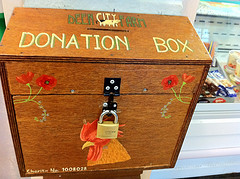
Greater use of data about donors and their preferences can help nonprofits improve their communications strategies. Photo credit: Howard Lake
Many nonprofit organizations can improve donor engagement by better using available data to develop more effective marketing strategies.
A survey by Abila, a provider of software and services to nonprofits and associations, shows that nonprofits are missing opportunities by not using donor preferences and data to drive strategy and tactics. Only 52 percent of donors believe the organizations they support take their preferences into account when communicating or appealing for donations.
Most nonprofits report that a single data point, donation amount, drives communications with donors. Nonprofits often ignore other pertinent information to develop deeper, longer lasting relationships – and can benefit by better applying additional donor data, including specific donor interests, to personalize communications.
“If organizations aren’t using donor data and what donors are telling them to drive strategy and communication tactics, then they are at jeopardy of having donor relationships that do not reach their full potential and/or risk losing the donor all together,” said Rich Dietz, director of fundraising strategy for Abila and study co-author.
These are other main findings of the survey of 1,263 donors and 206 nonprofit professionals:
Missed opportunities. Nonprofits often fail to target appeals or communications to their donors by age. Different age groups have marked differences in their communication and engagement preferences. When used strategically, those differences can improve relationships and improve engagement.
Fundamentals matter most. Donors want to know their money is being used wisely and makes a difference. They want to know that nonprofits are reputable and their mission is sound. If organizations don’t fulfill the fundamentals, no amount of strategy will help.
Communications may be too frequent. Nonprofits are 10 times more likely than donors to feel they’re not communicating enough, while donors believe the frequency is about right or in many cases too much. Many donors would like to see the frequency of some communications channels greatly reduced.
Quality beats quantity. High-quality content is more important than frequency or channel. Hearing personal stories, getting updates on accomplishments, and being thanked make donors feel more involved than the communications channel or frequency. Personal communication tops all other channels.
Giving makes donors feel good. Giving (or the act of giving) makes donors feel the most engaged. Volunteering is a close second. However, millennials feel more engaged through volunteering, with giving a close second. This would seem to indicate that more frequent giving in smaller amounts may result in larger total donations.
Different Survey, Similar Results
A survey by GiveCentral, 2015 Predictions for Nonprofit Giving, reveals roughly similar results.
Nonprofits are not measuring donor activity. Almost four-in-ten do not measure donor processing costs and therefore do not know if they are operating effectively. Less than one-third (31 percent) measure administrative costs; 23 percent measure related marketing costs.
Nonprofits are not keeping pace with technology. Just under half currently receive online donations. Only 6 percent receive donations via mobile devices. Paper checks are still the most commonly used form of receiving donations.
In addition, nonprofits’ donor communications often lack structure and organization.
The survey reports that 27 percent of nonprofits have no structured email schedule, 54 percent lack a timetable for phone calls, and 89 percent have no organized text messaging communication program, missing a significant opportunity to facilitate regular donor engagement.
Bottom Line: Recent surveys show that greater use of data about donors and their preferences can help nonprofits improve their communications strategies and thereby boost donations. By analyzing information about their donors and shaping communications based on donor preferences, nonprofits can improve donor engagement.
William J. Comcowich founded and served as CEO of CyberAlert LLC, the predecessor of Glean.info. He is currently serving as Interim CEO and member of the Board of Directors. Glean.info provides customized media monitoring, media measurement and analytics solutions across all types of traditional and social media.




